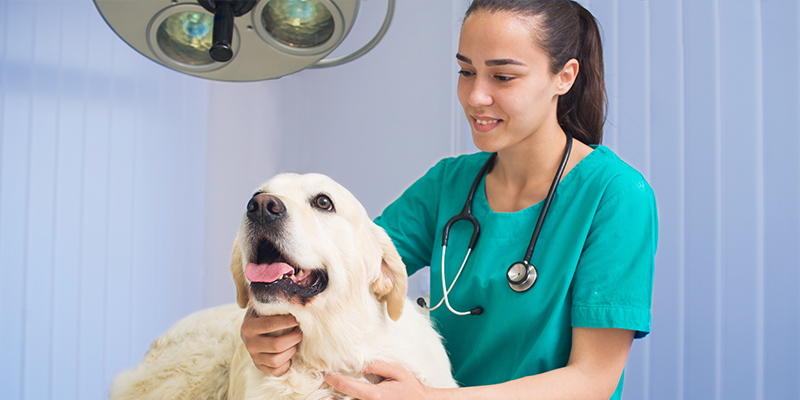
Summary
While medical radiation accounts for over 95 per cent of the population’s artificial radiation exposure, the occupational risk for veterinary workers is very low, with good practice. Exposures in veterinary practice can be more variable than in other occupations using ionising radiation.
What do I need to know?
Medical imaging in veterinary practices poses unique radiation protection challenges not present when imaging humans. Imaging modalities involving ionising radiation such as X-rays, CT scans and nuclear medicine are essential to making sure that animals receive the best care, however their wide variety of shapes, mobility levels and situations in which imaging may be required make occupational exposure more complex.
Many veterinary practices outsource their medical imaging requirements to specialist facilities. Although these facilities may have some occupational exposure challenges, good radiation safety practices and training as well as occupational exposure limits apply to protect workers.
Veterinary practices with in-house facilities or portable X-ray devices may encounter a variety of issues that may require changes in imaging set-up and more worker involvement. As a result, more personal protective equipment (e.g. lead aprons) is often required than is needed in other occupations. For example, using portable X-ray devices to image large, mobile animals gives rise to potential occupational exposures and challenges that are unique to veterinary workers. The desire to obtain a diagnostic image swiftly should never override the safety of workers, and radiation protection procedures should be put in place and followed at all times.
What is the possible exposure?
The two main sources of exposure for veterinary workers are: diagnostic x-rays and unsealed sources used in nuclear medicine. Once the power to the X-ray tube is turned off, or the source of radiation is removed, the exposure stops. External exposure in veterinary practices is very low, and with good practice should remain low. Internal exposure from X-ray equipment due to inhalation or ingestion risk is not possible. Internal exposure from unsealed sources due to inhalation and ingestion under normal conditions is unlikely.
ARPANSA has been monitoring and reporting on veterinary exposure for decades, there is a good understanding of the occupational exposure.
Most veterinary workers will receive annual occupational doses below the public limit of 1 mSv. If dose levels are higher than the public dose limit, then it would be advisable for the responsible person to review the work procedures.
In comparison average background radiation exposure in Australia is 1.7 mSv per year from natural sources and currently Australians are exposed to an average of 1.7 mSv per year from medical exposures.
What are the possible health effects?
Table 1: Possible health effects
| Dose range (millisieverts) | Description | Possible health effects |
|---|---|---|
| Up to 10 | Very low dose | None observed or expected (typical background range) |
| 10–100 | Low dose | Plausible health effects but not observed |
| 100–1000 | Moderate dose | Increase risk of cancer Acute effects at higher end of range (above 500 mSv) |
| Above 1000 | High dose | Acute effects (burns, vomiting) Death possible at very high doses (>5000 mSv) |
No health effects have been observed or are expected to be observed at the very low doses normally received in this occupation.
Ionising radiation has been proven to cause harmful short term effects at moderate and high doses received in short periods of time, above 500 mSv, with an increased risk of cancer shown to occur for long term exposures of above 100 mSv.
Many veterinary workers receive no occupational dose and those that do typically receive a very low dose that is a fraction of the occupational dose limits. Despite this, it is good practice to avoid or limit occupational dose where possible.
Who is responsible for your safety?
In Australia the use of irradiating apparatus and radiation sources is regulated. Each state and territory is responsible for enforcing their respective radiation safety act and regulations in their jurisdictions. The Australian government is responsible of enforcing the radiation safety act and regulations of commonwealth entities only.
Organisations/employers are responsible for:
- devising, implementing, and regularly reviewing their radiation management plan
- regulatory compliance
- induction and ongoing training of workers, including contractors.
Workers are responsible for:
- following radiation protection practices specified in the radiation management plan
- complying with legitimate instructions of the employer or designated radiation safety officer
- participating in radiation protection training.
What are dose limits?
All Australian jurisdictions have uniform annual limits for public and occupational exposure to ionising radiation: 1 mSv for the public and 20 mSv for workers who are occupationally exposed. Despite this, there are different definitions of who is ‘occupationally exposed’ and who should wear personal dosimeters. You can further discuss occupational radiation exposure with your facility’s Radiation Safety Officer or the relevant jurisdictional regulator.
For a pregnant radiation worker, the dose to the unborn child is restricted to the same as a member of the public – 1mSv. (See Management of Pregnant Workers Exposed to Ionising Radiation factsheet)


